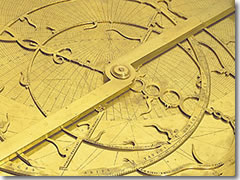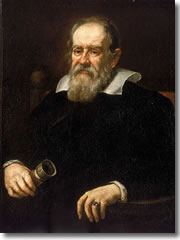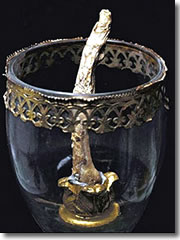
16th century brass astrolabe made in Florence by Egnazio Danti or Giovanni Battista Giusti (Photo
© Istituto e Museo di Storia della Scienza)Trust the Italians of yore to take something as workaday as a scientific instrument and turn it into a work of great art, sublime craftsmanship, and exquisite beauty.
This small museum's display cases overflow with intricately engraved astrolabes, compasses, dials, and other mechanical calculators.
There are Renaissance barometers and cluster thermometers, Chinese compasses and 18th century surgical instruments (hey kids: nightmare time!), and the telescopes Galileo invented to discover the moons of Jupiter.
Picking a favorite is tough.
There's the "ladies' telescope set" disguised as a makeup kit, so that women of means could appear to be proper and prim yet still indulge their (very un-lady–like) passion for science and study.
The adolescent boy inside me is totally jealous of the astrolabe that, with a few twists and folds collapses into a dagger—an Enlightenment-era Transformer that's both useful (in an appropriately seafaring, piratey way) and wicked dangerous!
However, none hold a candle to Galileo's bird.

Galileo Galilei, a portrait by Justus Sustermans (original in the National Maritime Museum in Greenwich, London—odd place to end up, yes, but by coincidence also home to really cool old astrolabes—but there's a copy in Florence's Museo della Scienza).Everyone has heard of the famous Pisan physicist (and mathematician, astronomer, and philosopher) Galileo Galilei.
This is the man who brought us the compound microscope, who theorized that two balls of unequal weight would still fall at the same velocity in a vacuum, who posited the laws of kinetics that laid the foundation for Newton's Laws, who created the first truly useful telescope (with which he discovered the moons of Jupiter, the craters on our own moon, and the existence of sunspots), and who was called by no less than Albert Einstein "the father of modern science."
Most people also know that Galileo was tried by the Inquisition for his heretical view that the Earth revolved around the sun—rather than the official theory that the entire universe revolved around us (to be fair, he cribbed this idea from Copernicus)—that he was found guilty, and was excommunicated from the church.
Few know what happened after that.
Since Galileo had powerful patrons, the Medici (he prudently named those moons of Jupiter after them), his actual sentence was pretty light, at least in terms of the Inquisition's typical overreactions: He had to recant, then live out his life under house arrest.
However, being found guilty of "vehement suspicion of heresy" meant that, when he died in 1642, at the age 77, rather than receiving the marble monument he deserved in Santa Croce, the church of choice for burying Tuscan cultural giants, he got a grave in a modest corner of the attached convent.
Though the Vatican gradually allowed Galileo's books to be reprinted over the course of the 18th century (censored, of course), and quietly dropped its own opposition to the heliocentric theory in 1835, it wasn't until 1992 that Pope John Paul II actually apologized for the church's treatment of Galileo and cleared his good name.
By that point, however, Galileo had already had the last word—and I don't mean just that we now revere his rigorous methods and study his theories in our science textbooks to this day, or that Stephen Hawking once said that, "Galileo, perhaps more than any other single person, was responsible for the birth of modern science."
I don't even mean the legend that holds that, after being forced to recant publicly his view that the Earth revolves around the sun, he supposedly muttered, "Eppur, si muove" ("And yet, it moves").

Galileo's middle finger. (Photo
© Istituto e Museo di Storia della Scienza)No, I mean that, in 1737, when his body was dug up to be moved under a proper funerary monument in the nave of Santa Croce (which proudly features an inlay of the Earth circling the sun), someone snipped off the middle finger of Galileo's right hand.
Since every church in Italy has its holy relics, why not its science museums?
Given the delight Italians take in their vast catalog of vulgar gestures, the placement of this middle finger cannot be mere coincidence.
Piazza dei Giudici 1 (just east of the Uffizi, where Via de' Castellani meets the river)
tel. +39-055-265-311
www.museogalileo.it
Weds–Mon: 9:30am–6pm
Tues 9:30am–1pm
€9.00
With Firenze Card: Free
Bus: C1; 23, C3; D
Hop-on/hop-off: Santa Croce (A), Corso Tintori (C); Demidoff (B), Lungarno Seristori (C)
Planning your day: The curious will only spend about 30 minutes; the intrigued maybe an hour (the joys of this museum lie in reading the placards by the displays and discovering all the little oddities).
The Galileo Museum is covered by the Firenze Card—free admission, no waiting in line. » more
Take a guided tour of Museo Galileo with one of our partners:
The museum reopened in summer 2010 after extensive renovation works. Among other innovations, they have become the first museum to offer portable video guides featuring short films, 3D animations, hypertext pages, and biographies.
Though I get a kick out of this place, I realize it's far from a must-see in Florence, so it gets just a single "star" in its rating. Still, if you're in town for more than three days and have some extra time—or are just sick and tired of Renaissance art—it makes for quite an interesting diversion.
Share this page
Search ReidsItaly.com
Piazza dei Giudici 1 (just east of the Uffizi, where Via de' Castellani meets the river)
tel. +39-055-265-311
www.museogalileo.it
Weds–Mon: 9:30am–6pm
Tues 9:30am–1pm
€9.00
With Firenze Card: Free
Bus: C1; 23, C3; D
Hop-on/hop-off: Santa Croce (A), Corso Tintori (C); Demidoff (B), Lungarno Seristori (C)